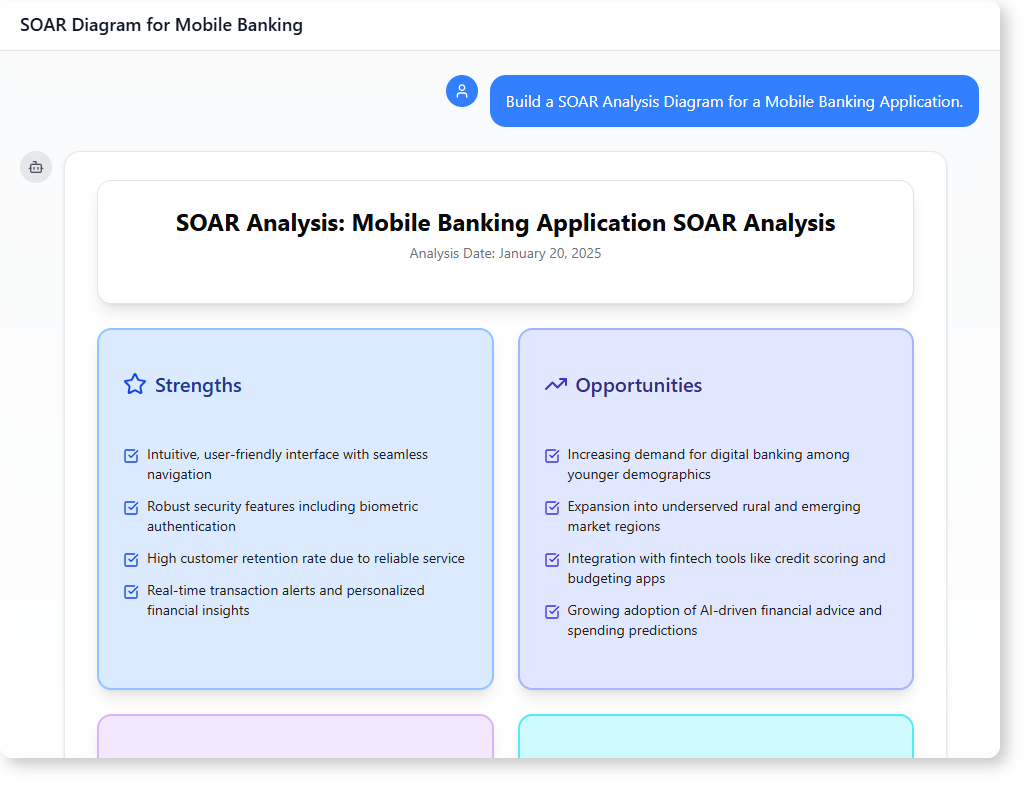Now Reading: How AI-Powered Modeling Software Builds a SOAR Analysis for Mobile Banking
-
01
How AI-Powered Modeling Software Builds a SOAR Analysis for Mobile Banking
How AI-Powered Modeling Software Builds a SOAR Analysis for Mobile Banking
How AI-Powered Modeling Software Builds a SOAR Analysis for Mobile Banking
Imagine a mobile banking team trying to understand what’s working, what’s missing, and where they want to go. Without a structured way to map it out, the conversation stays scattered.
That’s where AI-powered modeling software steps in. It doesn’t just generate diagrams—it helps teams turn strategy into a clear, visual framework. In this case, the software was used to build a full SOAR analysis for a mobile banking application, turning abstract ideas into actionable insights.

The process wasn’t about guessing. It was about asking the right questions.
The User’s Journey: From Strategy to SOAR Diagram
The user is a product strategy manager at a financial technology startup. Their team is launching a new mobile banking app and wants to ensure it aligns with customer expectations and market trends.
They needed to answer a simple but critical question: What does our current offering do well? Where can we grow? And what do we dream of achieving?
Instead of relying on spreadsheets or disjointed meetings, they used AI-powered modeling software to generate a structured SOAR analysis.
Here’s exactly what they did:
-
Started with a clear prompt: Build a SOAR Analysis Diagram for a Mobile Banking Application.
This initial request didn’t ask for theory or background—it asked for a visual framework that maps the core elements: Strengths, Opportunities, Aspirations, and Results.
-
The software responded with a structured diagram.
The AI generated a clean, professional SOAR analysis diagram that clearly separated each element. The layout made it easy to see how the strengths support customer trust, how opportunities open new growth paths, and how the aspirations define long-term goals.
-
Followed up with a narrative report:
The user then asked: Develop a detailed narrative report explaining how the SOAR elements connect and support the overall strategy.
The AI didn’t just list points—it explained the logic behind each element. For instance, it linked the intuitive interface (a strength) to improved customer retention, and connected growing demand from younger users (an opportunity) to the need for better financial literacy tools (an aspiration).
-
The result was a living strategy document.
The final output wasn’t static. It showed how each component of the SOAR model forms a coherent story. The strengths built trust. The opportunities revealed market gaps. The aspirations defined the future. And the results provided measurable goals to track progress.
Why This Matters for Modern Banking
Traditional analysis tools treat strategy as a checklist. This AI-powered modeling software turns it into a conversation.
- The strengths like biometric authentication and real-time alerts show the foundation of trust.
- The opportunities point to digital inclusion and integration with tools like budgeting apps, which can attract new users.
- The aspirations—like becoming the preferred platform in North America or offering financial confidence—set a human-centered vision.
- The results tie everything together with specific, measurable outcomes such as 50% active user growth and zero major breaches.
This structure helps teams avoid silos. It allows stakeholders to see how product decisions, customer needs, and business goals connect.
How AI-Powered Modeling Software Differs from Traditional Tools
Many tools focus on building diagrams from scratch. This one doesn’t require users to draw lines or define elements. Instead, it listens to the intent and builds a meaningful, context-aware model.
For a mobile banking team, that means:
- No need to memorize diagram templates.
- No guesswork about what elements belong together.
- A clear visual story that can be shared with executives, developers, and customers.
It’s not about replacing human judgment. It’s about helping teams see patterns they might otherwise miss.
Real-World Impact of the SOAR Analysis
After reviewing the output, the product team used the SOAR analysis to:
- Prioritize feature development (like spending predictions).
- Plan customer onboarding improvements (reducing steps from 4 to 2).
- Identify which markets to enter first (rural and emerging regions).
The AI didn’t just generate a diagram. It helped them build a strategy that felt grounded, credible, and future-ready.
Frequently Asked Questions
Q: Can AI-powered modeling software help with SOAR analysis for mobile banking?
A: Yes. It can generate a complete SOAR analysis based on your business context, helping you map strengths, opportunities, aspirations, and results in a clear, visual format.
Q: Is the generated SOAR diagram useful for internal discussions?
A: Absolutely. The diagram provides a shared language for teams to talk about strategy. It turns abstract ideas into visual narratives that everyone can understand.
Q: How does the AI understand the business context?
A: The AI uses context from your prompt. It interprets keywords like ‘mobile banking,’ ‘customer retention,’ and ‘digital adoption’ to build relevant elements and connections.
Q: Can this be used in other industries?
A: Yes. The same approach works for fintech, healthcare, or retail. The SOAR framework is flexible and adaptable across domains.
Ready to map out your system’s strategy with clarity and confidence? Give our AI-powered modeling software a try at Visual Paradigm’s AI Chatbot today!
